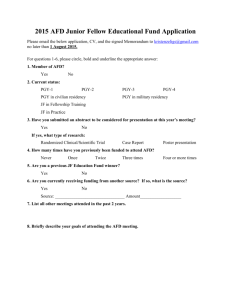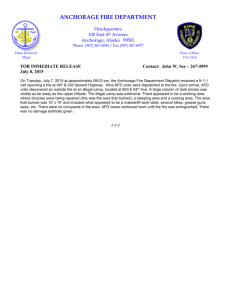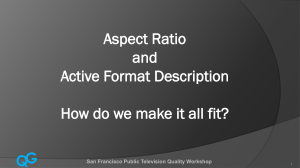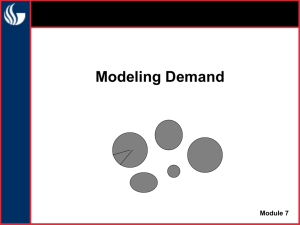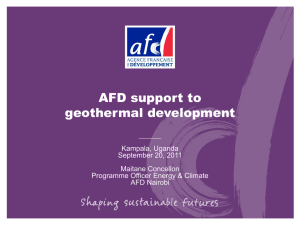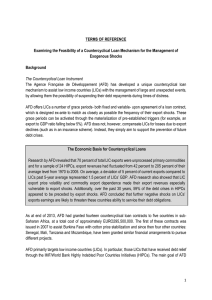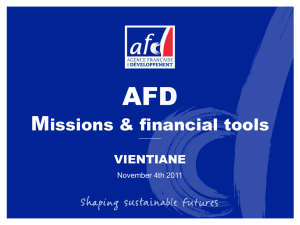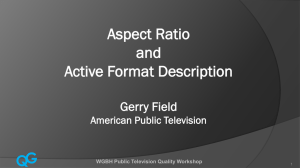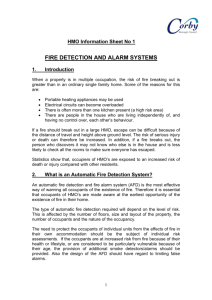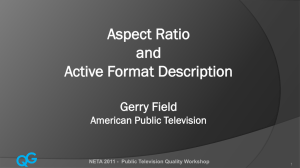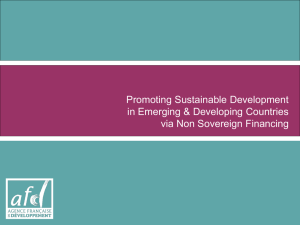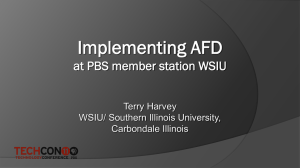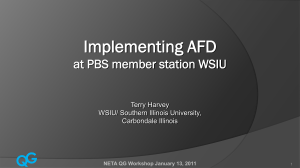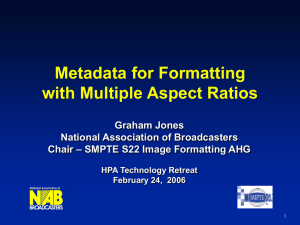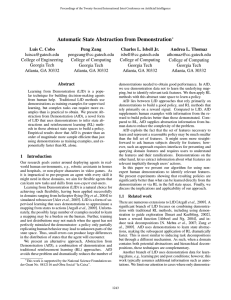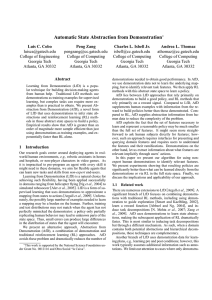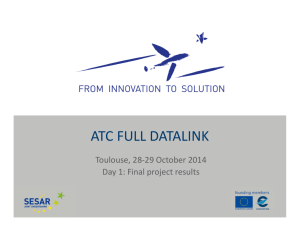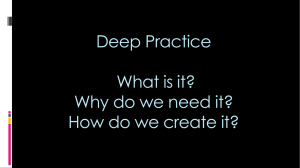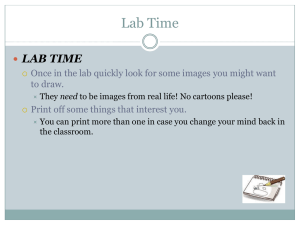In a 16:9 coded frame In a 4:3 coded frame In a 4:3
advertisement
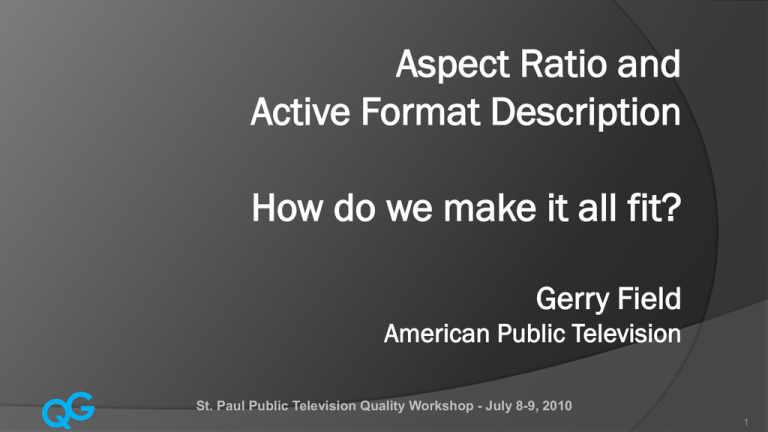
Aspect Ratio and Active Format Description How do we make it all fit? Gerry Field American Public Television QG St. Paul Public Television Quality Workshop - July 8-9, 2010 1 Aspect Ratio Television Aspect Ratio Defined: Picture frame: Ratio of image width to image height. Not directly tied to resolution. HD Screens are typically 16:9. SD Screens are both 4:3 and 16:9. Programming is varied. 16:9, 4:3, 15:9, 14:9, 1.85:1, 2.39:1 etc. Mixed aspect ratio programs QG 2 How do we make it all fit? We must deal with two display sizes 16:9 and 4:3. 16:9 sets have over 50% household penetration. Number of TV sets in the average U.S. household: 2.86. U.S. homes with three or more TV sets: 54% QG 3 How do we make it all fit? There are two programming sizes 16:9 and 4:3. Treat all widescreen as 16:9 unless we wish to crop other formats Upconversion, Downconversion QG 4 4:3 Image in a 4:3 Display QG 5 16:9 Image in a 16:9 Display QG 6 But…How do we make it all fit? 4:3 upconverted to 16:9 Fills the height of the 16:9 frame but leaves blank “pillar boxes” on the sides. Not a real problem if original quality is high. QG 7 4:3 Image in a 16:9 Frame QG 8 But…How do we make it all fit? 16:9 downconverted to 4:3 Fills the width of a 4:3 frame but leaves blank spaces on top and bottom. “Letterboxed” Not perfect for 4:3 but may be acceptable. QG 9 16:9 Image “Letterboxed” in 4:3 Frame QG 10 But…How do we make it all fit? 16:9 can also be “Center Cut” Downconverted to 4:3. This fills the height and width of a 4:3 frame but omits material on the left and right of the original image. QG 11 16:9 Image QG 12 16:9 Center Cut in 4:3 Frame QG 13 However….. Center Cut is only feasible if all active elements and graphics are maintained in the 4:3 center of the 16:9 image. “Center Cut Safe” – Action and Titles QG 14 16:9 Image in a 16:9 Display QG 15 16:9 Image center cut to 4:3 QG 16 Worst Case 4x3 Letterbox up converted to 16:9 Then down converted using a 16:9 to 4:3 down converter. “Postage Stamp”. QG 17 16:9 Image in a 4:3 Display QG 18 Up Converted to 16:9 as 4:3 QG 19 Down converted 4:3 Letterbox QG 20 What is the proper way to treat this? It depends. Commercial Networks Up Convert 4:3 with side panels. Down Convert 16:9 by Center Cut. PBS Stations Up Convert primarily 4:3 with side panels and Down Convert by Center Cutting or Letterboxing. QG 21 Anamorphic Commonly defines 16:9 “squashed” into 4:3 (Can also apply to 4:3 “stretched” to 16:9) Used as a distribution technique o Most common is SD widescreen on D-Beta Must be properly handled prior to emission If not, viewer sees “squashed” picture QG 22 Full Screen 16:9 QG 23 Anamorphic 4:3 QG 24 Anamorphic o Anamorphic or 16:9 SD programming may be upconverted to 16:9 HD and distributed (at a bandwidth cost). o Alternatively, 16:9 SD can be distributed with MPEG2 encoder flag set to 16:9. o 16:9 SD included in ATSC A/53 standard. o SD 16:9 can co-exist with SD 4:3 o Member station IRD will output correct format as desired. QG 25 If the MPEG2 flag is set to 16:9 at the MPEG2 Encoder, the Sencore IRD will properly recognize The format and provide properly formatted video 16:9 HD or 16:9 SD Sencore IRD MRD3187 Source SD 16:9 QG 4:3 SD Center Cut 4:3, 16:9 Letterbox SD Down Converting Some stations and channels are still SD only. 50 % of our viewers are still SD. Most HD households still have 2nd and 3rd SD sets. QG 27 Active Format Description - AFD A four bit code to define the active and protected image area. Intended to guide professional video equipment, consumer receivers and set-top boxes to optimize the displayed image. Very few ATSC receivers and consumer decoders act on AFD. QG 28 Active Format Description - AFD May also be used for format conversion signaling in the post and pre-broadcast chain. References: - SMPTE ST 2016-1:2009 - PBS TOS-1, 4.4 - PBS TOS-21, 4.3.7 - PBS Connect > Engineering/Compute > Technical Reference Library QG 29 AFD Codes SMPTE ST 2016-1:2009 defines 17 AFD Codes. Four are in common use: 1000 – Full Frame 1001 – Full 4:3 / Pillarbox 1010 – Protected 16:9 1111 – Center Cuts (14:9, 15:9, 2.35 etc. treated as 16:9) QG 30 AFD = ‘1000’ (Full Frame) In a 4:3 coded frame QG In a 16:9 coded frame 31 AFD = ‘1001’ (Full 4:3 / Pillarbox) In a 4:3 coded frame In a 16:9 coded frame In a 4:3 coded frame, AFD code ‘1001’ represents the same image display as AFD code ‘1000’. AFD code ‘1000’ is the preferred coding for a full frame 4:3 image QG 32 AFD = ‘1010’ (Protected 16:9) In a 4:3 coded frame QG In a 16:9 coded frame 33 AFD = ‘1111’ (Center Cuts) In a 4:3 coded frame QG In a 16:9 coded frame 34 Consumer Issues QG 35 Consumer Issues o Broadcasters cannot rely on consumers to maintain aspect. o AFD is not widely implemented on consumer devices. QG 36 So What do we do? Educate. Implement AFD. Discuss with Cable and Satellite providers to Implement AFD on their SD Down convert. Produce when appropriate 16X9 Center cut safe material. If necessary up convert Letterbox to 16X9 Full frame. QG 37 Questions? / Comments QG 38
